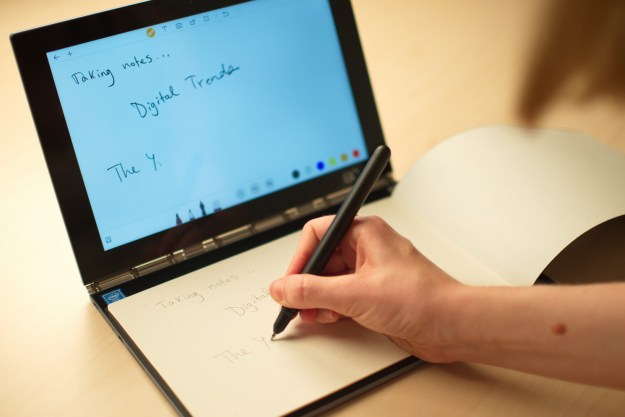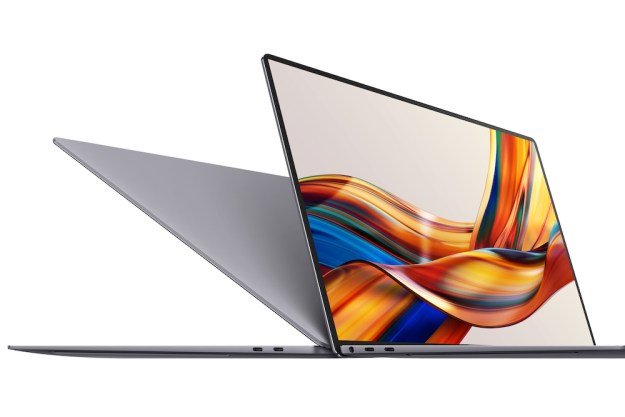
- Compact, sturdy build
- Innovative form factor transcends the 2-in-1
- Note-taking is excellent
- Accurate stylus
- Close to stock Android install
- Typing without keys feels strange
- Processor isn't powerful enough for a full laptop
- We don't know if it will get Android updates
Lenovo has never been afraid to try crazy new ideas. The Yoga Book may be its craziest venture yet. It’s an otherworldly product that doesn’t fit comfortably in any existing category. It’s kind of like a 2-in-1, because it’s a tablet and it has a keyboard (unlike any you’ve ever seen), but it’s so much more than that.
No other 2-in-1 has a touch-sensitive drawing slate that doubles as a notepad, and a crazy keyless keyboard that appears and vanishes with a touch of a button. The Yoga Book is truly unique, and for that reason alone, it’s one of the most exciting products we’ve reviewed this year.
A good idea is one thing, though. Executing it is another. We put the Android version of the Yoga Book through its paces to see if it’s a viable alternative to a laptop, or just a really unique tablet.
Innovative, sturdy design morphs to suit your needs
When it’s folded up, the Yoga Book looks like a 10-inch spiral notebook, but it folds out into a full computer using Lenovo’s signature 360-degree hinge, a staple of the Yoga line. It transforms back into a tablet or drawing slate with incredible ease. The device is also super lightweight at 1.52 pounds. It’s only 0.38 inches thick, which is absurdly thin for a tablet alone, and even more impressive for a tablet packing a touch-sensitive slate on its back.
The Yoga Book has a 10.1-inch Full HD IPS LCD touchscreen with 1,920 x 1,200 pixel resolution. It offers AnyPen stylus support, so you can use any conductive object on the screen as a stylus. But if you don’t have one, it also comes with a stylus that doubles as a real pen with ink, so you shouldn’t have to use random objects as styli.
On the other side of the hinge, a capacitive touch panel with EMR Pen Technology acts as a drawing pad when it’s in pen mode, and a capacitive keyboard when you need to type. In keyboard mode, the flat surface illuminates with your typical QWERTY keys. Each key provides haptic (vibration) feedback when you tap it. Since there aren’t any physical keys, it feels like you’re typing on a smartphone or tablet screen. The keyboard function also offers autocorrect and predictive typing, just like a tablet or phone’s keyboard. It works alright, but it does have a learning curve and is a keyboard that you’ll have to stare at as you type, to a degree. Physical buttons still work better for a laptop keyboard, so if typing is primarily what you’re buying it for, reconsider.
When you’re done typing, you can tap a button and turn it into a drawing slate. You can sketch on it just like you would on a super-sensitive Wacom tablet, and see your creations mirrored on the screen in full color. It’s a fantastic experience for artists and an even better one for note-takers. Lenovo includes a magnetic pad of paper, which attaches to the slate, so you can fold it back just like a real notebook and take notes. The stylus also comes with ink cartridges that are easy to find at any office supply store, and you can use any paper you like. If you attach the paper pad to the slate, you’ll have both a digital and an analog copy of your notes.
Android and Intel, a rare couple
Processing power is provided by an Intel Atom x5-Z8550 quad-core processor, and is paired with 4GB of LPDDR3 RAM. We didn’t run into any problems with performance while typing this review, running a number of Chrome tabs, and a flipping through handful of apps. We suspect the processor might be overburdened in the Windows version of the Yoga Book, but we haven’t had a chance to try it yet.
Note-taking is the Yoga Book’s killer feature.
However, in benchmarks, the Yoga Book fell behind the iPad Pro and the Surface Pro 4. The Yoga Book received 1,146 for a single-core score, and 3,194 for a multi-core score, on the Geekbench 4 test. It also scored 1,192 on the 3D Mark Slingshot test.
In contrast, the iPad Pro racked up 3,068 for its single-core score and 5,248 for its multi-core score on Geekbench 4. The Surface Pro 4 also bested the Yoga Book with a single-core score of 3,023 and a multi-core score of 6,304. To put all this in perspective, the very powerful MacBook Pro 13 with Retina got 3,007 on the single-core score, and 6,596 on the multi-core score. We should not that all of these devices are hundreds of dollars more expensive than the Yoga Book, but do give an insight into its power. This is more of a netbook than a laptop, power and size wise.
Obviously, the Yoga Book isn’t powerful enough to be a true laptop replacement, but we do like the form factor and hope that the next Yoga Book will be much more powerful. If it had a better processor, it’d be a stronger device. It’s a shame Lenovo didn’t go with a different chip. A lot of our reservations about would’ve disappeared. Then again, a price higher than $500 would be tough to swallow.

In terms of storage, Lenovo packed 64GB of storage into the device, which is expandable via a MicroSD card up to 128GB. That should be more than enough for most users.
In case you want to be that person taking photos with a tablet, there’s an 8-megapixel camera on the back and a 2-megapixel camera on the front for video calls and the occasional selfie.
The 8,500mAh battery inside the Yoga Book should last up to 15 hours on Android and 13 hours on Windows. In real life, we found it could last through a real workday without an issue. Depending on how much you use it, though, it could last you much longer.
Software and updates
Lenovo decided to make both an Android and Windows version of the Yoga Book, so you can have your pick of operating system. Windows 10 looks and operates as it always does, but
The extra apps are relatively useful, and Lenovo’s tweaks are also meant to give the Yoga Book more utility. It has a multi-window mode, so you can have several apps running in small windows next to each other; a bar at the bottom that shows all the apps you have open and Android’s navigation keys in the left corner; and TouchPal support for automatic keyboard corrections, which make it much easier to type accurately (most of the time).
Otherwise, the software is perfectly fine and we’re glad it’s close to Stock Android. The only issue is that
There have also been rumors about a merger between Chrome OS and Android. If that happened, the Yoga Book would be even more useful and practical as a laptop replacement. With Chrome OS and a better processor, the Yoga Book could be an intriguing to 2-in-1 device and possible laptop replacement.
Warranty information and availability
The Yoga Book has a one-year warranty, which you can extend for up to five years. You can check out all the warranty info here.

Lenovo offers a bungalow services in the warranty, including depot service, which covers parts, labor, and delivery to/from a repair center; onsite service, which covers parts, labor, and the technician visiting your location; Tech Installation Service, which covers onsite installation of replacement parts; and priority Technical Support 24/7.
You can buy the Yoga Book online now for $500. The Windows version costs $550. Every Yoga Book comes with the pen, three ink cartridge refills, and a notebook that attaches magnetically to the touch-sensitive slate. In a day and age when companies consistently charge extra for accessories, it is refreshing to see a device that comes with extras.
You can of course buy more of these accessories. The stylus costs $40, the paper costs $15, and the magnetic paper pad costs $20.
Our Take
If you’re looking for an excellent Android tablet, this is a top-class iPad Pro competitor at a cheaper $500 price. Its completely flat touch keyboard is a bonus, allowing artists and note takers (students, too) the only great option they’ve ever had for taking notes directly on a device and retaining them on paper, too. On the other hand, if you’re looking for a small laptop, this is not it. Though we didn’t have trouble typing this review on it, it isn’t a great device to type on all day. A cheap Chromebook may do you better.
Is there a better alternative?
There is nothing like the Yoga Book. No other device offers the ability to create digital and analog copies of your notes, make digital art and edit photos, and enjoy all the perks of an Android tablet.
However, we can discuss your alternatives based on what you need.
If you need a 2-in-1: Yes, there are better alternatives, all of which run Windows and have faster processors, including the Surface Pro 4.
If you need an Android tablet: There are no better alternatives. Samsung’s Galaxy Tab S2 is a decent option, but you get more with the Yoga Book for the same price. Obviously, if you don’t mind iOS, the iPad Pro 9.7-inch and Apple Pencil are a good pairing. You’ll pay a few hundred more dollars, though.
How long will it last?
The Yoga Book should last you several years. It packs a lot of processing power for an Android tablet, and it’s a durable design. The only issue might be software updates. Only time will tell how quickly the Yoga Book gets updates, and Lenovo doesn’t have the best history in that regard.
Should you buy it?
Yes, if you can accept that you are buying an Android tablet with some bonus features, not a laptop. Sadly, we cannot recommend the Yoga Book as a laptop replacement with this processor. It’s an excellent, innovative
Editors' Recommendations
- Best Apple deals: Save on AirPods, Apple Watch, iPad, MacBook
- Is this the best cheap Android tablet of CES 2024?
- The MacBook Air and iPad Pro could soon get a major upgrade
- Lenovo’s latest tablets have Android 12L and competitive prices
- WWDC 2022 announcements: iOS 16, iPadOS 16, WatchOS 9, MacOS Ventura, MacBook Air M2, and more







